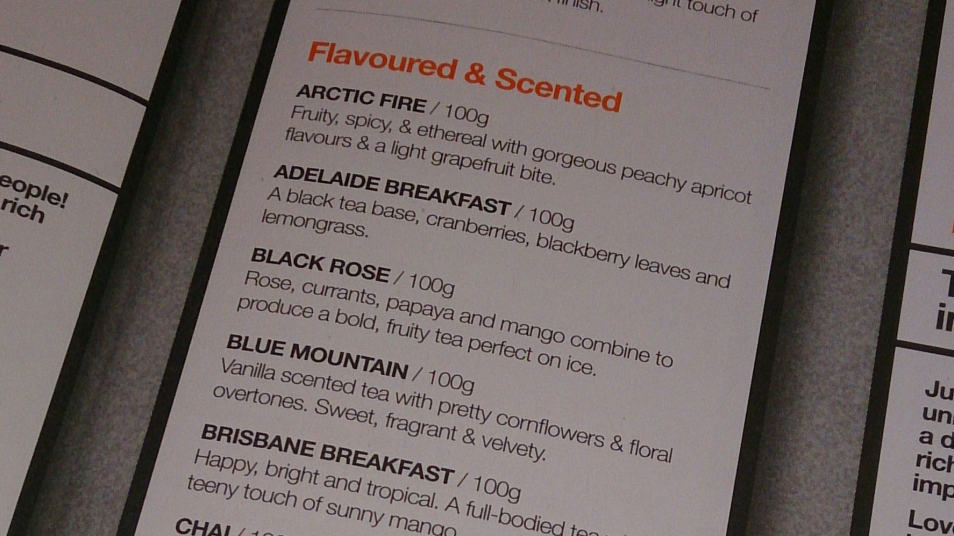The aroma, flavour and (dare I say it) spirit of tea reveals itself when leaf meets water. Sure, you can sniff the dry leaves and a more seasoned tea drinker can observe their shape and colour in order to take a good guess at quality and flavour, but you will only know the tea once it has been brewed.
This causes tea merchants a problem. How do they ‘wow’ you in their shop enough for you to make a purchase without having to brew up every tea?
The solution is simple – scent the tea. By adding aroma to a tea the merchants have an instant method of exciting customer senses. The smells are so intense that even the most nonchalant browser can be converted into a buyer just by whiffing the shop air.
The added advantage of using this technique is that they can use cheap tea and earn a higher margin because once it has been doused in flavourings, very few people will be able to taste the quality of the tea leaves. In one moment of business ingenuity, the tea merchants have taken a problem and found a solution which increases sales and profit margin.
Bravo to the marketeers but I have a problem with this aromatisation of tea. This is not because I am a tea purist – one look at the Mei Leaf menu will show you that I am not – or because I am a tea snob. The reason that it brings a dismissive tut to my lips is that this is being promoted as quality tea and sold as if it were all natural – it is the equivalent of adding artificial apple and blackcurrant flavour to a cheap red plonk and selling it off as fine wine.
Let me set the scene. You go to one of your no doubt, charming and well-informed friends for dinner. You are treated to a lovingly prepared meal full of culinary delights such as artisan sourdough bread, organic outdoor reared roast chicken with in-season vegetables all paired with a well-judged wine.
At the end of the meal, they ask if you would like a tea or coffee. You say ‘tea’ (of course) and they say that they have picked up some really good loose leaf tea. They rise and walk past their pride and joy Nespresso machine to open their tea cupboard. They pull out a few packs and have to remind themselves of the flavours.
You are offered a ‘Coconut and Ginger Green Tea’ or a ‘Wild Berry Oolong’. You decide to give them a miss and ask if they have any pure tea and they inevitably say ‘yes I have some Rooibos teabags’. None of what you have been offered is real tea yet these clearly food loving friends have been convinced otherwise.
I am of course not saying that your friends should avoid drinking that ‘Caramel and Noisette Black Tea’ if they enjoy it (although judging by the amount that they have left in the pack, it does not seem to be an everyday brew for them). What I am saying is that the emphasis in shops should be on promoting the variety of flavours in pure leaf first.
All the scented stuff should play second fiddle, a frivolous and fun distraction that should never upstage the star of the show. It is like walking into a fresh fruit and veg shop only to find that over half the shelves are taken up with artificially flavoured ketchup, cheap jams and chutneys.
This is not to say that all scented tea is poor quality. The Chinese have many classic blends (Pu Erh and Chrysanthemum Flowers) and scents (Jasmine, Osmanthus) but everything is natural and simple with tea being centre stage. These aroma blends are completely different. They usually use a poor quality tea base and at best they are scented with industrially extracted pure essential oils but most of them are supercharged with artificial aromas.
That ‘Green Apple and Egyptian Rose White tea’ (sound good huh?) may be beautifully mixed with dry apple pieces and red flecks of rose but please don’t be fooled by their natural appearance. The tea scenters usually soak those dry apples with ‘apple-y’ artificial fragrances and spray the tea with rose aroma. They might throw in a few other flowers to make it look pretty and colour the water. The result is a cheap-to-produce tea which looks exciting and smells intense – a guaranteed winner!
The disappointment comes when you brew your first cuppa. The boiling water hits the volatile aroma oils and you get a face full of scent as they evaporate away and you are left with a ‘meh’ tea that just tastes a bit flavoured.
So this is my call to action. I know that there is a pure tea out there for every palate and your friends should be tasting them. So the next time you spot a cupboard full of ‘Pina Colada Oolong’ please do the right thing and buy your friends a true tea present. If not for anything else, at least you know that you are guaranteed a great end to your next meal.







